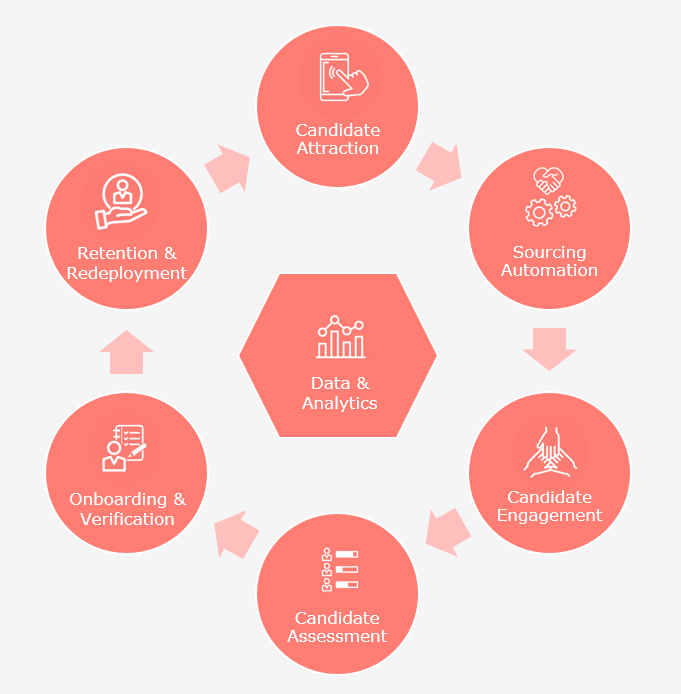- About us
- What we do
- Careers
- Investors
- Insights
- Client portal
Exploiting digital technology for Talent Acquisition

The events of 2020 have changed the course of talent acquisition and employment ‘norms’ forever. And within business, the decisions we make now will make or break us in the months and years ahead. How much to invest in technology is one such decision and with so many platforms on offer at each stage of the talent acquisition journey, it is a difficult one to make.
As part of our workforce solutions partnerships, we work with our clients to identify tech that can help them drive efficiencies, create cost-savings and enhance the candidate experience. If you’re looking for guidance on how to exploit technology in your talent acquisition process, take a look at our on-demand webinar or continue reading this article for a summary.
You may also be interested in our 9 key considerations when choosing your Applicant Tracking System article.
Over the past five years, the market for talent acquisition software has exploded in line with advancements in artificial intelligence and machine learning. From candidate attraction to retention and redeployment, technology is at hand to help improve the speed, quality and cost of hiring, as well as improving staff engagement and retention.
Let’s take a look at some examples of key technologies that can help at each stage of the talent acquisition process.
Candidate attraction
From job boards to search engine marketing (SEM) and platforms that distribute your job adverts to multiple platforms in one hit, there are many ways you can achieve efficiencies and increase your levels of candidate attraction. We want to highlight two; job post optimisers and job aggregators.
1. Job post optimisers
There are a range of digital platforms that enhance job postings and the application process but more than anything at the moment, the use of video is having a huge impact on the candidate attraction process; whether it’s video job descriptions, virtual interviews or even video CVs.
Until recently, video job posts have been seen as a novelty but as candidates become more accustomed to interacting with employers via video, it’s likely that it will see greater utilisation and engagement.
Recent reports claim an 800% uplift in engagement on job adverts where video is included (Cisco) and a 34% increase in applications on a job advert if it’s accompanied by a video (CareerBuilder).
2. Job aggregators
Whilst you may not be familiar with the term, your job postings may already be getting exposure through these platforms without you even realising. Job aggregators, like Indeed, ‘scrape’ employer careers sites, job boards and other publically available online sources to aggregate all job postings to a single platform – without any cost to you.
In the current hiring climate, it’s particularly important to understand the way these platforms work because you could use them to boost your job visibility if you’re offering remote working. As standard, they will only show jobs to candidates searching in your area. You can therefore massively increase your potential audience if you are offering remote working, but only if you clearly display this within the job location on your website where the aggregators are scraping your job information.
With ‘work from home’ job postings increasing by 28% since March (LinkedIn) this will be increasingly important to ensure your jobs appear for candidates searching for such opportunities.
Find out more about shifting candidate expectations in our Remote Recruitment webinar, which is available on-demand.
Sourcing automation
With many companies operating with a reduced workforce, process efficiencies are even more important right now. Here are two types of technology which can help speed up the sourcing process:
1. People aggregators
‘People Aggregators’ essentially enable users to search for candidates across multiple sources via a central platform. So you can enter in your search criteria and see results from your own database, as well as external sources such as LinkedIn, all in a combined list.
These tools can provide significant efficiencies beyond simply removing the need to log in to multiple separate systems. By collating all candidates, duplicates are removed and each candidate profile is populated using multiple data sources; giving you a well-rounded, complete picture of each person.
A people aggregator could also enable you to see where a candidate already exists on your own database, helping you save wasted CV database credits.
2. Sourcing process automation
Sourcing process automation tools take ‘people aggregators’ to the next level by applying artificial intelligence. These solutions enable searching across multiple sources before ranking candidates according to how well they match the job specification, or based on its understanding of how the user has ranked candidates previously. For example, if it can see that candidates with experience at a particular employer have typically been more likely to be shortlisted for this job title, then it will factor that into its ranking.
Candidate engagement
Candidate engagement solutions are focused on ensuring candidates are engaged throughout their journey from initial contact, through to deployment; something that is increasingly important in a climate with less ‘face time’ than ever.
From automated messaging that is triggered at key stages of the candidate journey, to chatbots on your careers website that facilitate the job application process and full candidate engagement platforms, such technologies can enable you to achieve huge efficiencies and enhance the candidate experience at the same time. Importantly they can also omit the need for additional resource that might otherwise be required to deliver a high-touch experience for candidates manually.
As with any tech offering, these tools range from basic to more sophisticated models so it’s worth really considering what value you want to get out of it before deciding on the appropriate platform for your needs.
Candidate assessment
From psychometric evaluations to skills-based tests and the traditional interview, there are many ways to assess suitability of candidates for a specific role. Whatever your preferred method of screening candidates, there is technology that can help conduct this in a virtual way.
Skills assessment
To date, skills assessment platforms have largely been used in the hiring of IT Development roles but could provide just as much benefit to roles outside of IT. Essentially, these platforms offer you the chance to test candidates’ skills and knowledge in a controlled online environment through setting a task and/or asking a range of pre-defined questions relevant to the role (which you can also customise). You can then view the results from all candidates within the platform.
Video interview platforms
The current situation has accelerated the acceptance and understanding of video technologies across almost all candidate groups, and building these technologies into your processes for the new normal, will be essential.
The capabilities of these platforms vary greatly. As well as enabling remote interviewing, they can allow one-way interviews, where the candidate is presented with some pre-defined questions and records them in their own time, before submitting their response to the hiring manager for review.
Platforms can also enable collaboration on comments and candidate ranking within the tool. However, ask yourself, what functionality you need in your business and select the appropriate tool for the job, as some with all the bells and whistles can be costly, and may offer minimal advantages to your business.
On-boarding & verification
In a recent poll we ran during our ‘remote recruitment’ webinar (read the summary article here), we asked attendees “What part of your recruitment process do you think will be hardest to adapt to the realities of remote working?”. The overwhelming majority chose on-boarding (63%) as the hardest to adapt to, with 13% choosing hiring and 24% selecting attraction.
With this in mind, it’s worth considering what changes you need to make to set your business up for a positive remote onboarding experience.
If you are using an existing HR system such as WorkDay or SuccessFactors, then it is likely the system will have a bolt-on solution for onboarding, and it will be essential for you to consider how you can make use of this technology, to capture documentation and deliver onboarding communications to keep candidates engaged throughout the process.
Your onboarding processes are likely to have been significantly disrupted and you can take this opportunity to make the move to adding automation into your process, not only to drive efficiencies, but also to deliver an enhanced candidate experience.
You may also wish to review the standalone onboarding products available, either because your current platform doesn’t offer a solution, or because it will be too time-consuming to implement into your legacy technology stack.
Retention & redeployment
Managing and engaging your remote workforce is a real challenge for businesses but, as per the theme of this article, there is technology that can help.
There are tools to aid workforce planning (like Foresight), platforms dedicated to administering staff benefits, performance management and learning systems, as well as software aimed at staff engagement and recognition.
Perhaps one of the biggest considerations around retention right now is what benefits you’re offering your employees. Benefits like discounted gym memberships and free fruit in the workplace simply aren’t as accessible as they were pre-COVID and, whilst you could manage changes to your benefits offering manually, there could be efficiencies to be gained by delivering your benefits via a dedicated benefits management platform such as Darwin.
Engagement and recognition is especially important in the remote world of working. Platforms like Peakon can deliver surveys to your employees to capture feedback and sentiment to enable consistent measurement and analysis of engagement levels.
If you enjoyed reading this article, why not check out the full 30 minute webinar on-demand, where our digital expert, Tristan Ray, explains these technologies in more detail.
Alternatively, you can access more workforce insights and resources here.

